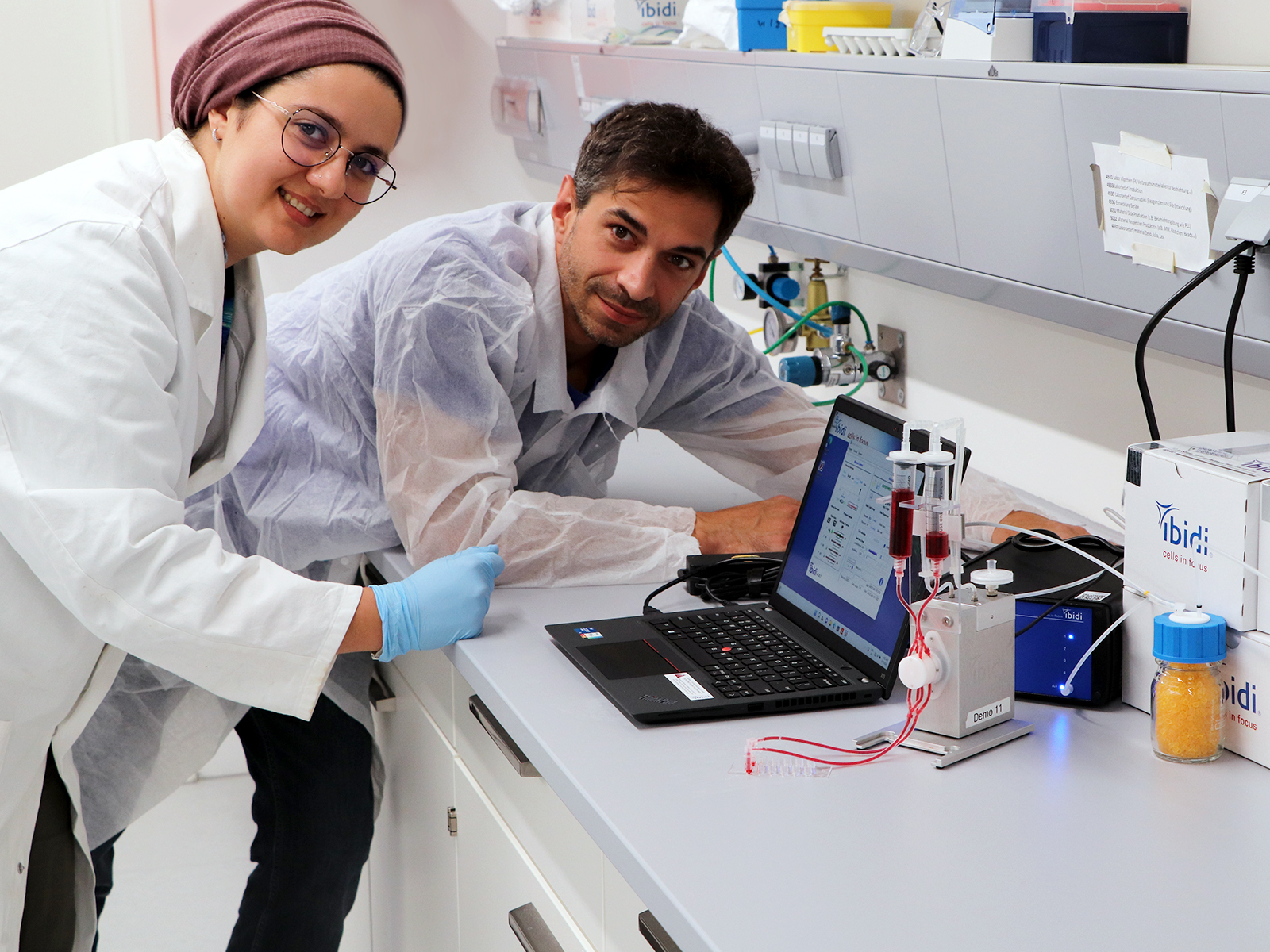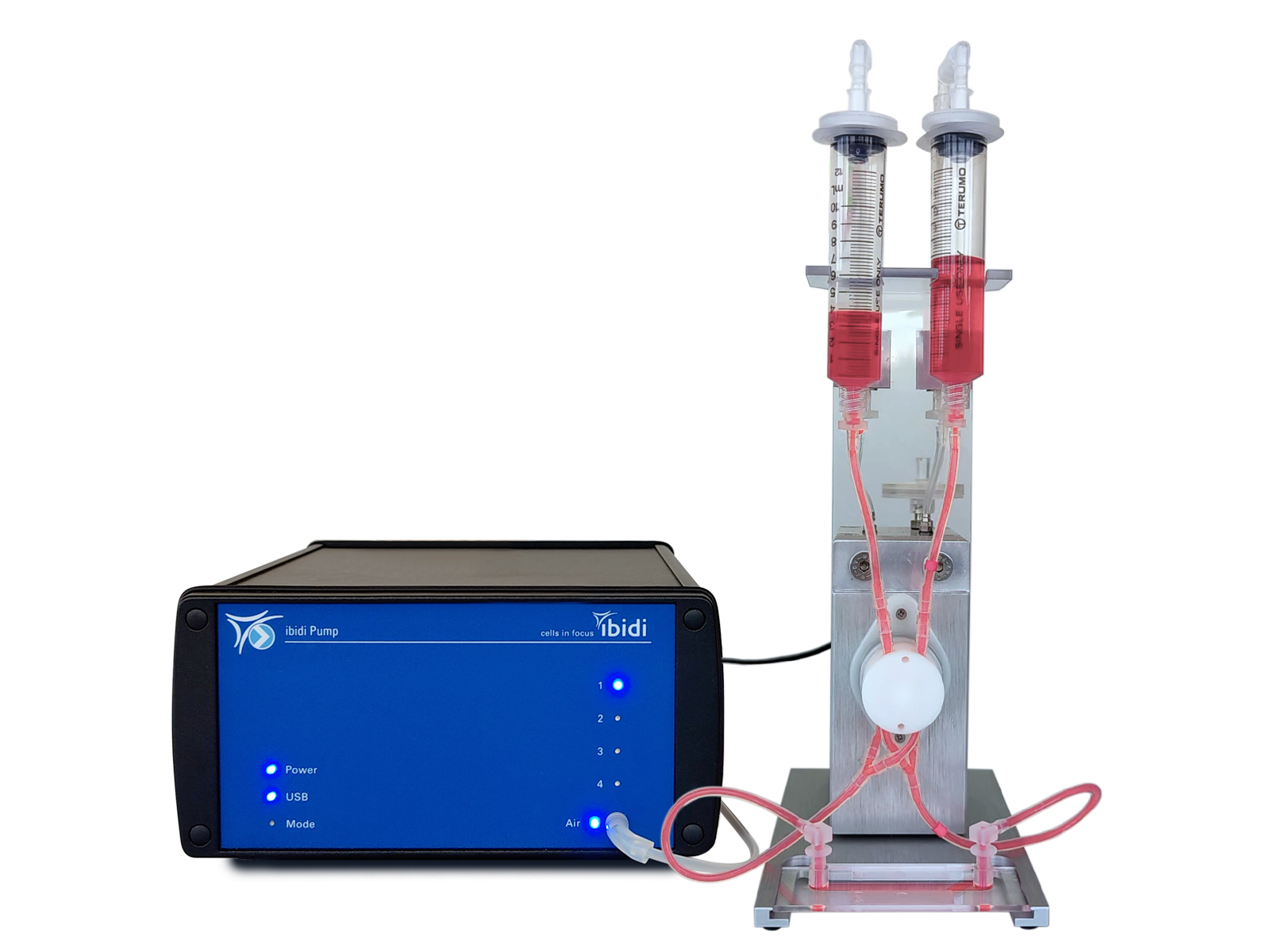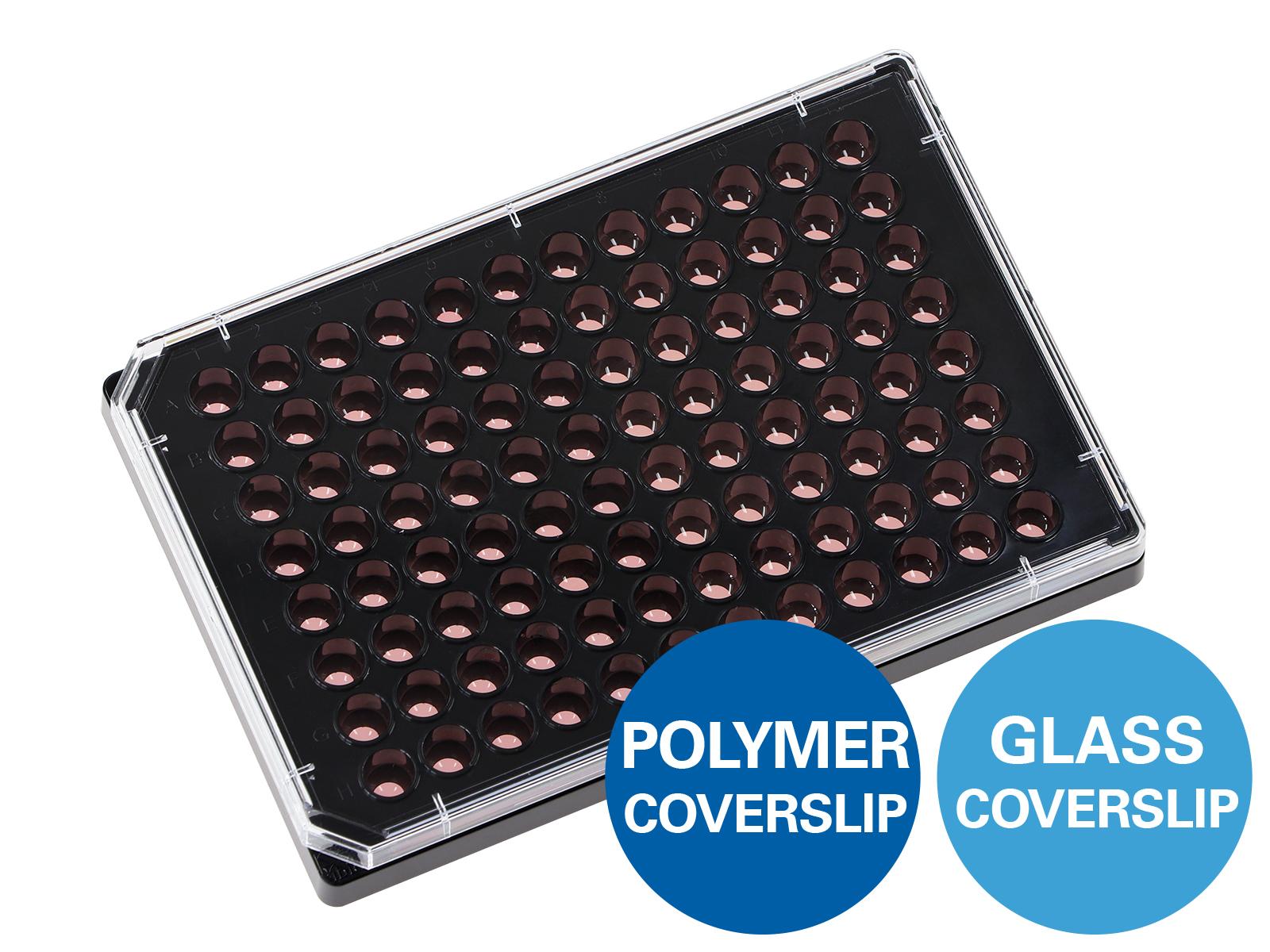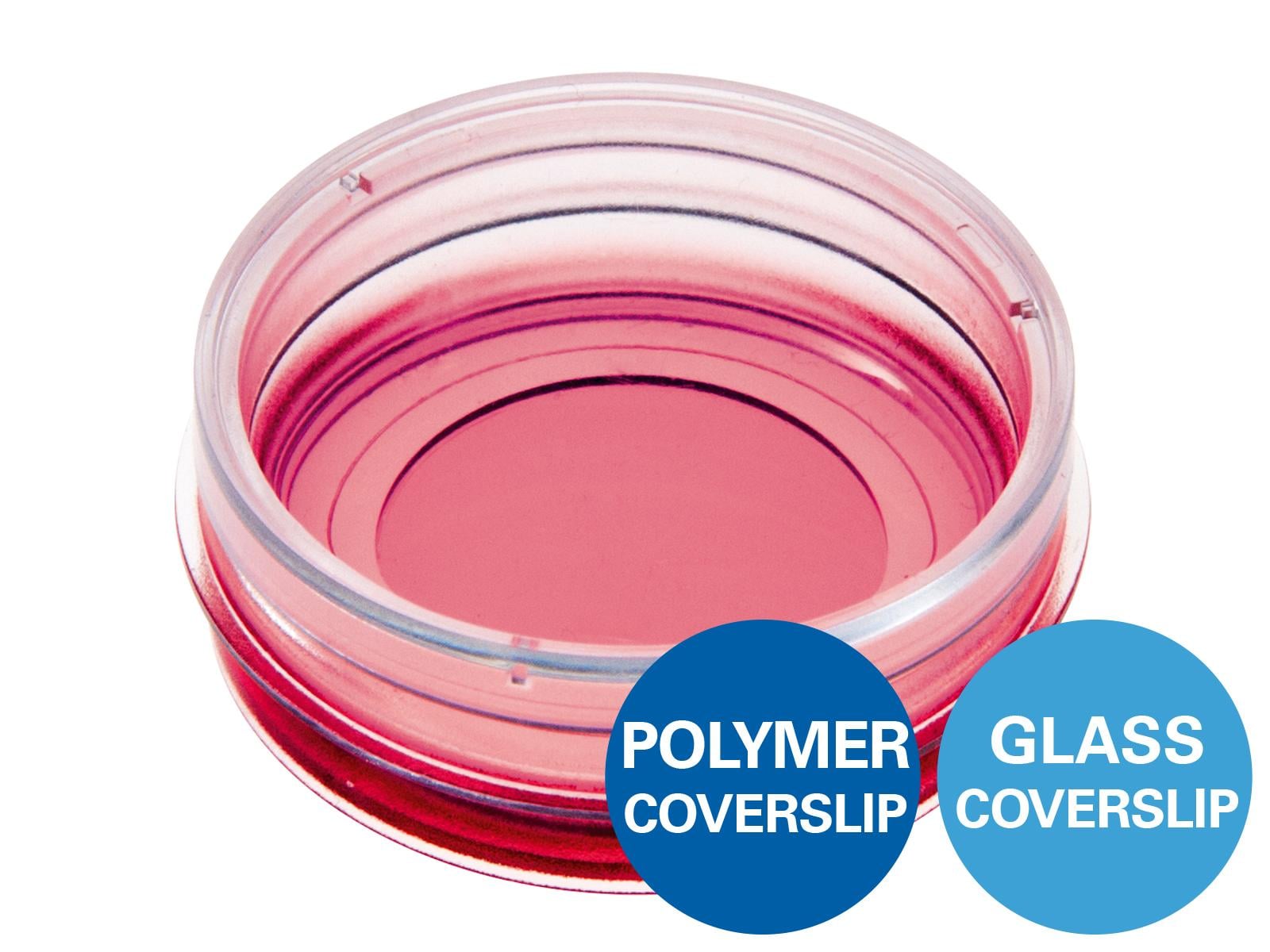ibidi Produces 1000th Instrument for the Simulation of Vessels
>> Pressemitteilung auf Deutsch lesen
Munich, Germany, July 2, 2024—The Bavarian biotechnology company ibidi GmbH is celebrating the delivery of its 1000th Pump System. With it, ibidi has achieved what many have been searching for. In a compact space, it supplies living cells with nutrients and simultaneously exposes them to flow, as is common in blood vessels or internal organs. This allows cells to be studied under almost physiological conditions. The patented innovation has suddenly created new research possibilities without the need for animal experiments. The excellent setting of the ibidi Pump System is utilized by scientific and industrial laboratories worldwide for their experiments. So, they are significantly expanding the knowledge of cells, their structure, function, and behavior in a flow environment. With this understanding of cells, new methods and drugs are being developed to treat cardiovascular diseases or immune system disorders.

In the ibidi laboratory: Test setup of the ibidi Pump System.
https://ibidi.com/img/cms/about_us/press/ibidi_pr_2024_06_pump_01.jpg

The ibidi Pump System.
ibidi.com/img/cms/about_us/press/ibidi_pr_2024_06_pump_02.jpg
This small marvel of technical ingenuity has become a milestone in cell analysis and diagnostics. Whereas cells in a medium in a (Petri) dish used to grow statically, the medium now uniformly and continuously flows through the cell area. For the first time, the ibidi Pump System simulates the situation of many blood and immune cells within a few centimeters, with very simple handling and at a reasonable price. The cells need this flow of the medium also over a long period as a mechanical stimulus to behave as they do in the body.
“When developing our pump system, we always followed the ibidi motto ‘cells in focus’,” summarizes Dr Valentin Kahl. He heads the jointly founded company with Dr Roman Zantl.
"Our focus was on providing cells with a permanent feel-good package of temperature and gas mixture/ pH-value as well as constant flow. We also wanted to enable a sterile, antibiotic-free experimental setting and live microscopy in a high-tech environment. I am very proud that we have succeeded in doing this so smartly!"
Structure of the ibidi Pump System
The ibidi Pump System consists of three elements: an electric pump, a software-controlled fluidic unit and a slide with a small channel. Thin tubes connect the elements, positioning the channel slide between the two liquid reservoirs on the microscope, with the electric pump standing beside it. All together it is smaller than a toaster and is easy to operate. Computer-controlled, the pump compresses air, which moves the liquid through the attached channel slide. Because it is a closed system, the flow direction can be predetermined by the sophisticated geometry of the device – always in the same direction, as is found in the vessels of the circulatory system. A total volume of just 10 ml is sufficient, due to the clever design, to supply the cells with everything they need to survive for several weeks.
In addition, the innovative valve concept generates different fluid profiles, allowing the fluid to flow over the cells in various ways and speeds. It creates pulsatile profiles for differently timed start/stop/start rhythms, oscillating profiles for defined directional changes, and unidirectional profiles for continuous flow in the same direction. By changing the flow velocity, a wide range of conditions can be simulated: from gentle flow in tissue, supplying it with nutrients and transporting waste products, to medium flow velocities in kidneys or veins, up to strong flows in arteries or even injured blood vessels.
A particularly noteworthy feature is that the pump system can be operated directly in the cell culture incubator. Usually, electrical devices massively change the balanced ratio of heat and gas mixture/pH-value, causing the cells to suffer or be destroyed and the device to corrode. However, in the ibidi Pump System, the pressure generation and boost are decoupled. This means that the electric pump is located outside the incubator, while the liquid thrust is transferred inside via air pressure. Meaning, the cell culture and the electrical device both remain intact.
The ongoing experiment can be observed in real time using standard microscopy. The ibidi channel slides, in which the cells grow so beautifully, are of high optical quality, they transmit light without interference. High optical quality in combination with an ideal environment are usually a contradiction, but the ibidi founders knew how to combine them with many patent-protected innovations. Therefore, the view of living cell nuclei, organelles, and the interaction of several cells is unobstructed, even in high-resolution microscopy, while applying flow.
“We have just sent the 1000th Pump System to Athens – and our first ones are still running stably!”, says a delighted Wolfgang Oeffner, who cleverly designed the electric pump. Since then, the ibidi Pump System has enabled many pioneering cell experiments. The best results appear in internationally renowned scientific journals (as so-called ‘papers’) to promote progress in human and animal biology, medicine, and pharmacy.
An Example of Changes Induced in Cells Under Flow
Endothelial cells line the inner walls of blood vessels. They react noticeably when the initially resting liquid above them is suddenly set in motion. The flow exerts a mechanical stimulus on them in the form of shear stress. Under the new demands, they quickly change their morphology, i.e. their appearance and structure, as their cytoskeleton aligns itself in the direction of flow. However, the mechanical force of the flow has a much deeper effect and influences the biochemical function of the cell. As soon as the cell's ‘external antennas’ (the receptors) sense the flow of its environment, they motivate the cell's own genes to produce endothelial cell-specific building blocks. As a result, the cell develops particularly efficient ‘anchoring feet’ (adhesion molecules) allowing it to cling to the surface and resist the forces of the flow. Many other processes and mechanisms can be observed from the altered gene expression and protein synthesis of cells under flow.
Steps into the Future
The properties of the ibidi Pump System are in high demand. 3D Cell biology is currently striving to develop good cell-based models of spheroids and organoids, i.e. miniature spatial laboratory moulds with body-like organ functions. The ibidi Pump System is also being used here. Unlike the static cell culture of the (Petri) dish, it has already solved the most urgent problem, the constant supply of nutrients to living cells and cell clusters. To add to this, many creative ibidi slides are now available, which offer researchers every possibility for cell experiments – with different surfaces, in several
channels and planes, with active ingredient reservoirs and computer-controlled conditional changes. One pump system can even control four different parallel experiments.
"We see ourselves as pioneers, helping to close gaps in knowledge with our product innovations. The Pump System is one of these – its success is motivating! We are currently expanding the functional scope of the pump system with the aim of supplying three-dimensional cell cultures with nutrients over very long periods of time. This transition to the third dimension makes it possible to replicate human organs or even tumours to carry out biomedical research without animal testing under conditions typical of the human body,” predicts Dr Roman Zantl.
More About the Fluid System with the ibidi Pump
More information about the ibidi Pump System can be found on our website.
About ibidi GmbH – ibidi.com
ibidi GmbH, Graefelfing, is a leading provider of functional cell-based assays and products for cell microscopy. The extensive product range offers solutions for classic cell culture as well as for complex assays, such as angiogenesis, chemotaxis or wound healing. ibidi's products facilitate the understanding of the development and treatment of various diseases. ibidi's customers work around the globe in research institutions, in the research-based pharmaceutical industry, and biotechnology. The products are distributed worldwide.
Press Contact
Karin Leonhardt, M.A.
ibidi GmbH
Lochhamer Schlag 11
82166 Gräfelfing
Tel.: +49 89 520 46 17 385
kleonhardt@ibidi.de
https://ibidi.com
ibidi fertigt 1000. Instrument, um Blutgefäße zu simulieren
Gräfelfing, 2.7.2024 – Das bayerische BioTechnologie-Unternehmen ibidi GmbH feiert die Auslieferung seines 1000. Pump Systems. Mit ihm ist gelungen, wonach viele suchten. Auf kleinstem Raum versorgt es lebende Zellen und setzt sie zugleich unter Fluss, wie in Blutgefäßen oder inneren Organen üblich. So können Zellen in nahezu körpergleichen (physiologischen) Bedingungen wirklichkeitsnah untersucht werden. Damit hat die patentgeschützte Innovation schlagartig neue Forschungsmöglichkeiten geschaffen, ohne auf Tierversuche zurückgreifen zu müssen. Das exzellente Setting des ibidi Pump Systems nutzen Wissenschafts- und Industrielabore weltweit für ihre Experimente. So erweitern sie umfassend die Kenntnis von Zellen, deren Aufbau, Funktion und Verhalten in einer fließenden Umgebung. Mit diesem Zellverständnis entstehen neue Methoden und Wirkstoffe, um Herz-Kreislauf-Erkrankungen oder Störungen des Immunsystems zu behandeln.

In the ibidi laboratory: Test setup of the ibidi Pump System.
https://ibidi.com/img/cms/about_us/press/ibidi_pr_2024_06_pump_01.jpg

The ibidi Pump System.
ibidi.com/img/cms/about_us/press/ibidi_pr_2024_06_pump_02.jpg
Das kleine Wunderwerk technischer Findigkeit ist zu einem Meilenstein in der Zellanalytik und -diagnostik geworden. Waren bisher Zellen in einem Medium in der (Petri-)Schale vor allem statisch gewachsen, durchströmt nun das Medium den Zellbereich gleichförmig und dauerhaft. Erstmals also simuliert damit das ibidi Pump System in sehr einfacher Handhabung und zu vernünftigen Preisen auf wenigen Zentimetern die Situation vieler Blut- und Immunzellen. Denn sie benötigen dieses Strömen des Mediums als mechanischen Stimulus auch über einen langen Zeitraum, um sich wie im Körper zu verhalten.
„Wir haben uns auch bei der Entwicklung unseres Pump Systems immer am ibidi Motto orientiert ‚cells in focus‘ – die Zellen im Blick behalten.“, fasst Dr. Valentin Kahl zusammen. Er leitet mit Dr. Roman Zantl die gemeinsam gegründete Firma. „Unser Augenmerk lag darauf, Zellen dauerhaft ein Wohlfühlpaket aus Temperatur und Gasgemisch/ pH-Wert sowie stetem Fluss zu bieten. Außerdem wollten wir hier unbedingt steriles, antibiotikafreies Experimentieren und gleichzeitig Live-Mikroskopie im HighTech-Bereich ermöglichen. Ich bin sehr stolz darauf, dass uns das so smart gelungen ist!“
Aufbau des ibidi Pump Systems
Das ibidi Pump System besteht aus drei Elementen: einer Elektropumpe, einer software-gesteuerten Flüssigkeitseinheit und einem Slide mit einem kleinen Kanal. Dünne Schläuche verbinden die Elemente miteinander, so dass das Kanal-Slide zwischen beiden Flüssigkeitsreservoiren auf dem Mikroskop liegt und die Elektropumpe danebensteht. Alles zusammen ist kleiner als ein Toaster und leicht zu bedienen. Computergesteuert erzeugt die Pumpe Druckluft, welche die Flüssigkeit durch das Kanal-Slide bewegt. Weil es ein geschlossenes System ist, kann durch die raffinierte Gerätegeometrie die Fließrichtung vorgegeben werden – auch immerwährend in die gleiche, wie es in den Gefäßen des Blutkreislaufes üblich ist. Schon 10 ml Gesamtvolumen reichen in dem geschickten Aufbau, um den Zellversuch sogar über mehrere Wochen mit allem, was zum Leben benötigt ist, zu versorgen.
Darüber hinaus erzeugt das innovative Ventilkonzept verschiedene Flüssigkeitsprofile, lässt also die Flüssigkeit in unterschiedlicher Weise und Geschwindigkeit in den Zellversuch einströmen. Es schafft pulsatile Profile für verschieden getaktete Start/Stopp/Start-Rhythmen, oszillierende für definierte Richtungswechsel und unidirektionale für den kontinuierlichen Durchfluss gleicher Richtung. Zudem lässt sich mit veränderter Fließgeschwindigkeit viel simulieren: vom sanften Durchfluss im Gewebe, welcher dieses mit Nährstoffen versorgt und Abfallstoffe forttransportiert, über mittlere Fließgeschwindigkeiten in Nieren oder Venen, bis hin zu starken Flüssen wie in Arterien oder gar verletzten Blutgefäßen.
Besonders ungewöhnlich ist, dass das Pump System direkt im Zellkultur-Brutschrank betrieben werden kann. Denn dort ändern Elektrogeräte sonst das austarierte Verhältnis von Wärme und Gasgemisch/ pH-Wert massiv, wodurch die Zellen leiden oder zerstört werden und das Gerät korrodiert. Aber im ibidi Pump System sind Pumpleistung und Anschub entkoppelt. Deshalb kann die Elektropumpe außerhalb des Brutschrankes stehen, während sie über den Luftdruck den Flüssigkeitsschub ins Innere weiterreicht. Zellkultur und Elektrogerät bleiben so jeweils intakt.
Mit gängigen Mikroskop-Typen wird das laufende Experiment in Echtzeit beobachtet. Denn die ibidi Kanal-Slides, in welchen die Zellen so schön wachsen, sind optisch hochqualitativ, also störungsfrei lichtdurchlässig. Sonst ist das ein Widerspruch in sich, welchen aber die Erfinder von ibidi mit vielen patentbeschützten Innovationen zu verbinden wussten. Deshalb fällt auch in der Flusssituation hier der Blick frei auf lebende Zellkerne, Organellen und die Interaktion mehrerer Zellen selbst in hochauflösenden Mikroskopieverfahren.
„Das 1000. Pump System haben wir gerade nach Athen verschickt – und unsere ersten laufen immer noch stabil!“, freut sich Wolfgang Öffner, der die Elektropumpe klug konzipierte. Das ibidi Pump System hat seitdem viele wegweisende Zellexperimente ermöglicht. Die besten Ergebnisse erscheinen in international renommierten Fachzeitschriften (als sogenannte „Paper“), um den Fortschritt in Human- und Tierbiologie, Medizin und Pharmazie zu befördern.
Ein Beispiel für die Veränderungen von Zellen unter Fluss
Endothelzellen kleiden die Innenwände von Blutgefäßen aus. Sie reagieren augenfällig, wenn die zunächst über ihnen ruhende Flüssigkeit auf einmal in Bewegung gesetzt wird. Denn der Fluss übt auf sie einen mechanischen Reiz, in Form von Scherspannung (Shear Stress), aus. Unter der neuen Beanspruchung verändern sie schnell ihre Morphologie, also Aussehen und Struktur, indem sich ihr Zellskelett in Fließrichtung ausrichtet. Aber die mechanische Kraft des Flusses greift weitaus tiefer und beeinflusst die biochemische Funktion der Zelle. Denn sobald die „äußeren Antennen“ der Zelle (die Rezeptoren) das Fließen ihrer Umgebung spüren, motivieren sie die zelleigenen Gene endothelzell-typische Bausteine zu produzieren. Daraufhin entwickelt die Zelle besonders effiziente „Anker-Füßchen“ (Adhäsionsmoleküle), mit denen sie sich an der Oberfläche festhält und sich den Kräften des Flusses entgegenstemmt. Viele andere Vorgänge und Mechanismen lassen sich aus der veränderten Genexpression und Proteinsynthese für Zellen unter Fluss beobachten.
Schritte in die Zukunft
Die Eigenschaften des ibidi Pump Systems sind höchstgefragt. Denn die Zellbiologie in 3D strebt aktuell danach, gute zellbasierte Modelle von Sphäroiden und Organoiden, also räumliche Labor-Kleinstformen mit körperähnlichen Organfunktionen, zu entwickeln. Auch hier kommt das ibidi Pump
System zum Einsatz. Denn anders als die statische Zellkultur der (Petri-)Schale hat es das vordringlichste Problem, der ständigen Versorgung von lebenden Zellen und Zellhaufen schon gelöst. Zudem liegt inzwischen eine Vielzahl kreativer ibidi Slides vor, welche der Forscherphantasie alle Möglichkeiten für Zellversuche bietet – mit unterschiedlichen Oberflächen, in mehreren Kanälen und Etagen, mit Wirkstoffreservoiren und computergesteuert fein veränderbaren Bedingungen. Sogar vier parallel arbeitende, unterschiedliche Experimente kann ein einziges Pump System zugleich bewegen.
„Wir verstehen uns als Vorreiter, um neue Wissenslücken mit unseren Produktinnovationen schließen zu helfen. Das Pump System ist eine davon – ihr Erfolg motiviert! Momentan erweitern wir den Funktionsumfang des Pump Systems, mit dem Ziel dreidimensionale Zellkulturen über sehr lange Zeiträume mit Nährstoffen zu versorgen. Dieser Übergang in die dritte Dimension ermöglicht die Nachbildung von menschlichen Organen oder auch Tumoren, um biomedizinische Untersuchung ohne Tierversuche unter körpertypischen Bedingungen durchzuführen.“, sagt Dr. Roman Zantl voraus.
Mehr zum Flüssigkeitssystem mit der ibidi-Pumpe:
Weitere Informationen zum ibidi Pump System finden Sie auf unserer Website.
Über die ibidi GmbH – ibidi.com
Die ibidi® GmbH, Gräfelfing, ist ein führender Anbieter funktioneller zellbasierter Assays sowie von Produkten für die Zellmikroskopie. Seine umfangreiche Produktpalette bietet Lösungen für die klassische Zellkultur sowie für komplexe Assays, bspw. Angiogenese, Chemotaxis oder Wundheilung. Durch die Produkte von ibidi wird das Verständnis von Entstehung und Behandlung unterschiedlicher Krankheiten erleichtert. Die Kunden von ibidi arbeiten rund um den Globus in Forschungseinrichtungen, in der forschenden Pharmaindustrie und der Biotechnologie. Der Vertrieb der Produkte erfolgt weltweit.
Pressekontakt
Karin Leonhardt, M.A.
ibidi GmbH
Lochhamer Schlag 11
82166 Gräfelfing
Tel.: +49 89 520 46 17 385
kleonhardt@ibidi.de
https://ibidi.com




